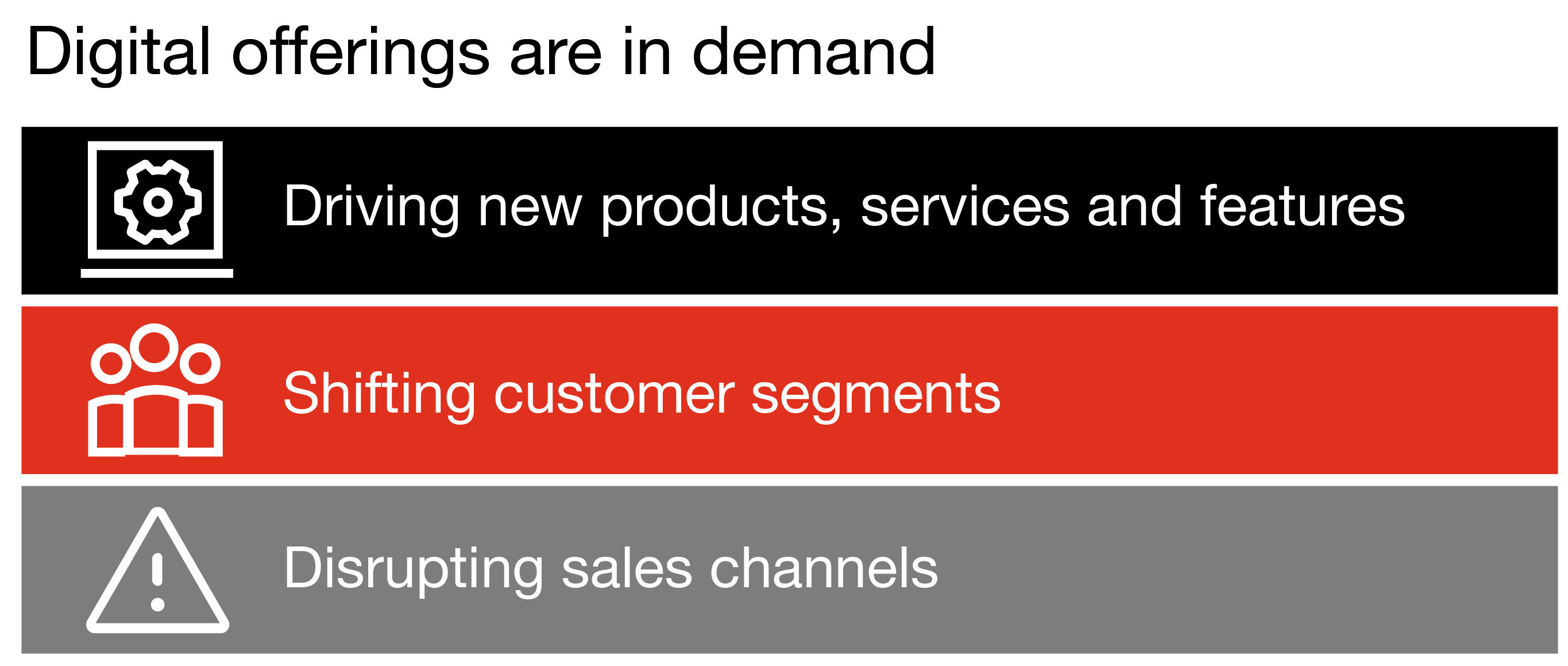As shifting priorities imprint the business landscape in response to COVID-19, customer preferences and expectations are following suit. Digital trends already underway are now accelerating. Some software and digital platform companies are experiencing an increase in demand for their products and services. Meanwhile, others are dealing with enterprise customers who’ve been forced to cut costs to preserve liquidity. The winners will collaborate with customers on delivering value—business value to enterprise customers. By focusing on their customers, software and digital platform companies can emerge stronger through the recovery and beyond.

Adjusting to changing customer expectations
Restrictions on business as usual are transforming customer preferences and expectations. With traditional ways of doing business currently unavailable, customers are turning to digital alternatives. Trends towards online business—already in progress before the onset of COVID-19—are now accelerating.
Consumers are looking to digital platforms to deliver what they need quickly and conveniently. Many shoppers—even those who may have once resisted digital options—are now embracing various on-demand platforms to fulfill basic needs. Grocery and food delivery services have enjoyed a boost in the number of users, as have media streaming and online education services. Some companies, such as Amazon and Instacart, have been forced to scale up quickly while others—in hospitality and transportation for example—have had to scale back in the face of uncertainty.
Meanwhile, enterprise customers have adapted quickly to shelter-in-place mandates, increasing demand for products and services—especially from software companies providing cloud-based connectivity tools and systems. Software companies have also concurrently had to find creative ways to connect with enterprise customers virtually to maintain ongoing engagement during the pandemic and beyond. Conferences and in-person meetings, the lifeblood of many B2B sales teams, have been canceled or moved online. Software providers have also had to be sensitive to the economic pressures their customers face, especially in some industries.

Refocusing on customer needs
Software and digital platform companies are starting to prepare for the possibility that a certain portion of shifting behaviors—including remote work, entertainment and education—will outlast the crisis. For example, Facebook has announced permanent changes to its remote work policy. Their behaviors will likely affect both B2B and B2C companies, necessitating changes in roles, products and services. Sales organizations, for example, will need to be more digitally focused while also maintaining a human level of engagement. For example, software sales executives are setting up studios in their homes to deliver professional-level digital interactions for enterprise customers.
Regardless, predicting what is here to stay will be more difficult for companies that don’t maintain close ties to their customers, as well as those who don’t proactively shape the future. While the challenges they face are pressing, software and digital platform companies are poised to help define this new reality.
They have the advantage of a deep understanding of their customers and partners gained via access to data analytics and insights. Recommitting to core values—including a sharp focus on customer needs—they are clear-eyed about the innovation needed to drive results, and prepared to experiment quickly to deliver.
Digital platforms such as Doordash, Postmates, UberEats and Netflix have attracted a raft of new customers who are sheltering in place at home. Platform companies are well advised to preserve those relationships beyond the recovery and monitor unit economics by managing scaled infrastructure and challenging transaction volume predictions. Streaming companies with muscular content libraries, for example, are well-positioned to keep customers engaged over the long term.
Enterprise software companies are evaluating new customer success models that align technical, sales and support teams by client. They have the opportunity to adopt new technologies, automate manual processes and connect more deeply with customers in the wake of a global pandemic that has necessitated cultural acceptance of a more modern approach.
Recommended steps
To emerge stronger through the recovery and beyond, software and digital platform companies are collaborating in lockstep with their customers to create a vision of what success will look like in a post-COVID-19 environment. They are experimenting with new products and services—drawing on customer feedback and focus groups—to adapt in a post-COVID-19 environment. PwC recommends these steps to succeed in the new normal:
Study your customers—they've changed
The extent of customer impact from COVID-19 varies by segment, industry, geography and market position. Regardless, customers now take priority over all other activities for software and digital platform companies. Work with enterprise clients to understand and help navigate their distinctive challenges, whether staying afloat, meeting current needs, preparing for the future or the entire gamut. Determine what tools and technology might work best to assist them in each situation, from price stability to talent deployment to cloud connectivity. Deploy data and analytics to help predict buying behavior and track new customer segments, renewed engagement from existing customers and changing customer expectations. Armed with that knowledge, invest appropriately to reignite engagement with former customers while also scaling up to meet demand for new products based on evolving customer priorities.
Top takeaways
- Assess customer risk by segment, geography and market position.
- Address customer needs using appropriate tools and technology for each situation.
- Deploy data and analytics to track changing behavior and new customer segments.
- Invest to reignite customer engagement and scale up to meet new demand.
Expand the boundaries of your sales team
Now more than ever, customers expect timely solutions that fit their needs. Some sales teams are underutilized in the current environment due to reduced enterprise spending. Implement digital training to help them address evolving customer priorities and update their skills and competencies. Develop a culture that keeps remote sales teams invested, connected and engaged to curb turnover and burnout. And provide real-time feedback. Organize them by industry to better understand and address the challenges customers face—and innovate to provide business value for customers. Build long-term relationships by focusing on customer needs rather than sales quotas.
Stay connected with channel partners, too, and prioritize how best to help them. Treat your most valuable channel partners as you would your most valuable customers—they are an extension of your sales force. Offer valuable resellers access to the tools and resources available to your sales teams. Virtually meet your ecosystem players (partners of your channel partners, such as their developer network) where they are by offering online versions of conferences, events and certification at reasonable rates.
Top takeaways
- Implement digital upskilling training to bridge gaps in understanding of customer priorities.
- Stay connected to channel partners to inform innovation and enhance customer value.
- Invest in ecosystem players through online training and events at reasonable rates.
Adopt customer success models
Customer success teams focus exclusively on the customer’s business goals instead of the traditional sales focus on products, features and upgrades. They function as business partners for the customer’s entire business cycle. Salesforce, for example, is building a customer success organization dedicated to ensuring customers have the right products and services to maximize their business value. These customer success professionals work as part of in-house teams with customers—often onsite but more virtually of late—to advise them in real time on how best to tailor tools and systems for their specific growth needs. Companies with fewer resources could train their sales teams to use a hybrid approach, applying the practices and incentives that focus on maximizing business value for customers rather than traditional sales metrics. For consumer platforms, adjust your expectations for your customer success team using rating criteria better aligned with customers’ changing needs.
Top takeaways
- Focus on the customer’s business goals.
- Function as a business partner to customers by advising them in real time.
- Revisit rating criteria used to evaluate customer success teams for alignment with customer’s goals.
Push the limits of innovation
The response of digital platforms such as Amazon and Google to the current public health crisis has offered consumers a renewed appreciation of their capabilities. Customers are giving companies the license to develop new offerings, products, features and more, recognizing that they stand to gain from these innovations as long as certain privacy measures are in place. The time is right to push the boundaries of product, platform and digital prowess; without innovation there is no path forward. Invest in talent and capabilities to support these efforts. Develop a close connection between engineers, product managers, field sales teams and channel partners—those in the field will have the earliest indicators of changing customer needs, particularly in a time where forecasting is difficult. Facebook, for example, is offering a new service that allows merchants (many of them small businesses) to sell products directly through its platform, enlisting third-party partners to handle back-end functions.
Top takeaways
- Push forward with developing new offerings, products and features.
- Communicate the customer benefits of each innovation.
- Underscore privacy measures.
Authentically elevate your brand
Purpose matters, as tech, media and telecom (TMT) companies acknowledged in PwC’s COVID-19 CFO survey: They are almost twice as likely as all sectors (28% versus 16%) to increase their philanthropic commitment in the wake of the pandemic—and to sustain this level of commitment for the foreseeable future. And amid the protests and conversations around race prevalent across the country, software and digital platform companies are uniquely possessed of the scale and technological know-how to live their purpose, partnering with other organizations to lift up underrepresented groups and communities in need. Microsoft, Uber and Grindr, among others, are leading by example. Build your brand by supporting essential services. Leverage your strengths as a platform to provide opportunities for customer donations.
Top takeaways
- Leverage tech know-how to live out purpose.
- Partner with other organizations to serve communities in need.
- Offer opportunities for customer philanthropy.
By focusing on their customers, software and digital platform companies can emerge stronger through the recovery and beyond.
Emerging stronger
COVID-19 is transforming customer expectations, serving as an accelerant for the widespread virtual connectivity already underway. Software and digital platform providers have to prepare for a future in which some of the trends taking shape are here to stay. The key to their success will be an ongoing, empathetic dialogue with customers. Fortunately, these companies are well-positioned to lead the recovery by leveraging their strengths as customer-centric, community-focused, innovation-powered brands.
Contact us

Emmanuelle Rivet
PwC US Chief Risk Officer, PwC US
Responsible for overseeing firmwide risk management strategies, operations and risk identification, and mitigation, helping the firm to build and maintain trust with clients and deliver quality outcomes.

Robert Moline
Partner, PwC US
Seattle








